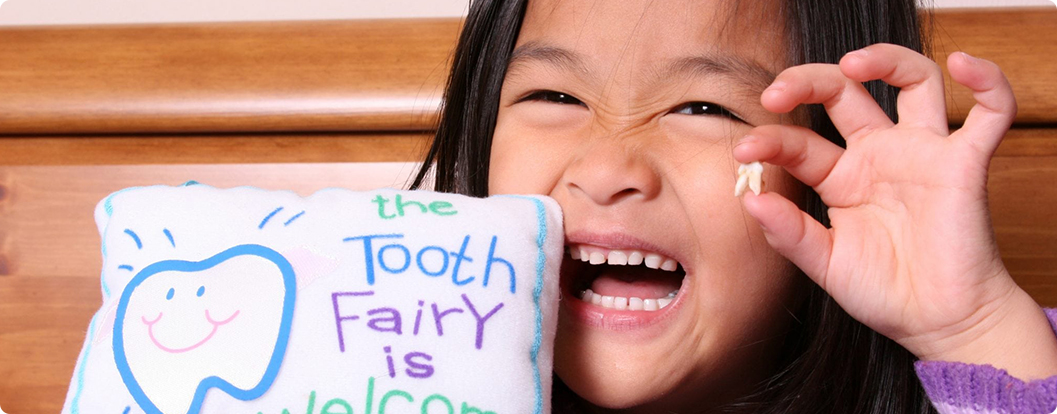Oral History: Origin of the Tooth Fairy
Though anyone reading about the tooth fairy today can’t remember a world without her, the mythical creature we envision is less than 100 years old! She first made her American print appearance in 1927 in The Tooth Fairy: Three-act Playlet for Children by Esther Watkins Arnold. While the playlet is no longer in print, the legend has lived on in Western culture to this day.
Despite her relative out-of-the blue appearance, few people had ever questioned the ritual of handing over money for a child’s lost tooth until the 1970s. According to this 2014 Salon article, a radio DJ in Chicago referenced the tooth fairy, setting off a firestorm of questions about the origin of the tooth fairy to the totally unprepared American Dental Association. At the same time, Professor Rosemary Wells of Northwestern University Dental School began asking her own questions. Professor Wells researched the history of the tooth fairy and became the self-proclaimed Tooth Fairy Consultant. She even ran a museum out of her home for several years.
Young Myths for Old Traditions: How Old is the Tooth Fairy?
While our American tooth fairy is a fairly modern sprite, brought to life mostly from the imaginations of modern animators and illustrators starting at the end of WWII, traditions based on childhood tooth loss go back through the centuries. Many rituals involved throwing the teeth into the sun or a fire, burying or hiding the teeth, or even swallowing them. If you ask someone from France or Spain how old the tooth fairy is, they might answer that the tooth fairy is at least 300 years old, but it’s not a female fairy. Their tooth fairy is actually a mouse!
The French La Bonne Petite Souris, or Ratoncito Pérez for the Spaniards, was a mouse who snuck the tooth from the child’s bed at night and granted the child’s wish for strong permanent teeth. Because rodents have such strong teeth themselves, it was believed the rodent would collect teeth as a sacrifice and give the child new teeth like his own. As the 20th century in America ushered in whole new ideas of hygiene, you can imagine how the idea of a mouse in the house became decidedly less popular. With the rising popularity of fairies in movies and children’s stories, the American tooth fairy took on her spritely winged identity. Now we have our own history of the tooth fairy that is uniquely American and modern.
Until very recently, we at FlutterPop had been the tooth fairy’s very confidential consultants in preparing updated tricks and tools for the digital age. Now that the tooth fairy is almost ready to go digital, we are proud to help spread the word! Please sign up for our mailing list to become a tooth fairy insider!
What Does She Do With All Those Teeth: Why Does the Tooth Fairy Collect Teeth?
We’ve seen how much the traditions about collecting baby teeth have evolved, but what has remained consistent throughout many ages and cultures is that we all do something with those teeth. We’ve taken a look at the history of the tooth fairy and approximately how old the tooth fairy is, but the question still remains, why does the tooth fairy collect teeth?
To answer this question, let’s go back to the tooth fairy folklore. The general consensus is that tooth loss is usually the first milestone a young child is able to recognize and remember for himself. This rite of passage marks the beginning of the end of childhood, and it can be a very unsettling experience. What better way to soothe your child’s mind than to leverage his youthful belief in magic and make it a positive experience? Yes, the child has lost something, a part of herself, in fact. But for her belief and bravery in this time of uncertainty, she will be rewarded with a shiny coin.
The older traditions of symbolically throwing teeth into the sun, burning them in a fire, or burying them in a special place give evidence that marking this time of growth and development has been significant throughout time. Many traditions were carried out to bring about good fortune, or at least to ward off bad luck.
More modern takes on the practice of collecting a tooth in exchange for money are that it is a simple lesson in capitalism for children. Since kids can’t produce any goods on their own yet, they use what they have, an unneeded tooth, and exchange it for cash. They begin to learn how the free market works and are on their way to learning how to trade money for goods and services. We have to admit, while this is a worthy lesson, we’d rather believe the magic!
Is your child nervous about losing teeth and the fairy who will come to take them? Visit our shop for several books that will gently calm and prepare your child for this time of change. For more fun news on the origin of the tooth fairy and to stay up to date on our website progress, sign up for our mailing list and follow us on Facebook and Instagram!

